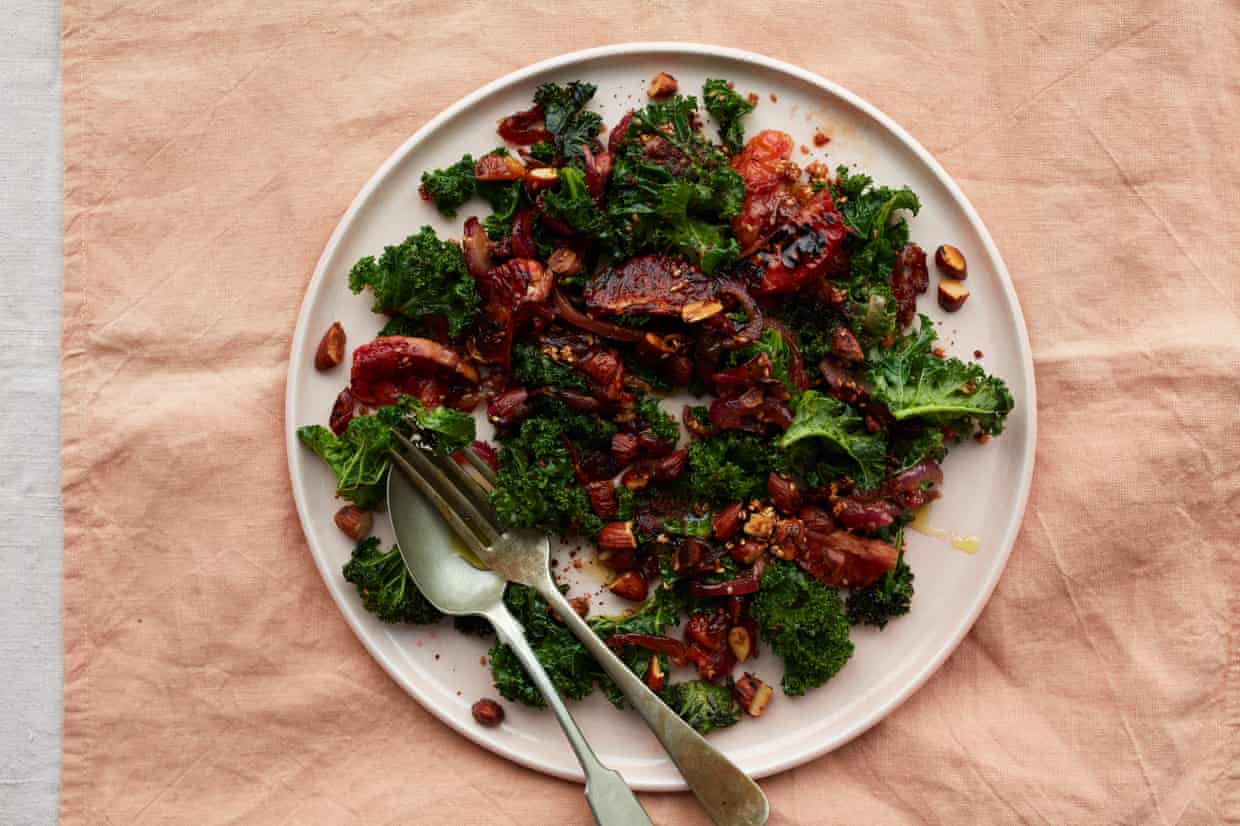
The modern cook
Salad and sticky cake: Anna Jones’ blood orange recipes
The blood orange is a chink of light in the dark of midwinter. Make a meal of them in a rich, warm salad bursting with citrus punch, followed by a spicy, sticky cake
by Anna JonesI am a food nerd. Every year when foods I like come into season, I get as excited as a normal person might about a new coat or seeing an old friend.
Right now, it’s blood oranges that have my attention. Dip dye ruby red when you cut into them, blood oranges arrive just when we need them: when it’s bleak outside. I realise I am a special type of nerd and, for a lot of people blood oranges are hard to find (if so, use clementines), while some won’t even notice that they have come and gone. That’s why one of today’s recipes is for cake, which I’ll bet will get a few more of you excited, anyway.
A warm salad of sticky blood orange and kale (pictured top)
A warm salad that eats well on its own with some garlic-rubbed toast or crisp-edged roast potatoes. Clementines work well here in place of the blood oranges.
Prep 15 min
Cook 25 min
Serves 2 as a main, 4 as a side
Olive oil
1 red onion, peeled and finely sliced
1 garlic clove, peeled and finely sliced
2 blood oranges, peeled and segmented
2 tbsp sherry vinegar
1 tbsp runny honey
400g kale, hard stalks removed, leaves torn into bite-sized pieces
30g almonds or hazelnuts, roughly chopped
2 tbsp sesame seeds
Zest of an unwaxed lemon
1 tsp sumac
Heat a little oil in a large frying pan, add the onion and garlic, and cook on a medium heat for eight to 10 minutes, until soft and sweet (make sure you keep stirring so it doesn’t catch).
Once the onions are cooked, add the blood orange segments, sherry vinegar and honey. Cook for four to five minutes, until the oranges are starting to caramelise and catch around the edges; be brave here, because the blood oranges will be wet at first, then, as the liquid dries off, they will caramelise. Tip the lot out on to a plate.
Add a little more oil to the pan, add the kale, turn up the heat and cook for a few minutes, until the kale has lost its rawness and its edges are crisp.
Meanwhile, mix the nuts, sesame seeds, lemon zest and two tablespoons of olive oil, and cook in a small frying pan for two to three minutes, until crisp and starting to brown.
Tip the kale into a serving bowl, toss with the oranges, then sprinkle with the nuts, sesame seeds and sumac.
Rooibos and blood orange cakes

Brown sugar, ginger, toasty rooibos tea and blood oranges come together to make a caramel-topped cake that January cries out for. Use clementines if blood oranges are hard to find.
Prep 20 min
Cook 40 min
Makes 12
For the cakes
75ml whole or oat milk
3 rooibos (AKA redbush) tea bags
220g salted butter, at room temperature, plus extra for greasing
150g light brown muscovado sugar, plus 60g for the tins
3 blood oranges, zested, then peeled, pith removed, cut into 1cm-thick discs
4 large, organic eggs
220g self-raising flour
½ tsp baking powder
4 dates, chopped
3 tbsp freshly grated ginger
For the rooibos caramel
2 rooibos/redbush tea bag
50g light brown muscovado sugar
25g butter, cut into cubes
Heat the milk in a pan and, just before it comes to a boil, take it off the heat. Add the tea bags and leave to one side to steep.
Grease a 12-hole muffin tin with some soft butter. Add a heaped teaspoon of the light muscovado sugar to each greased mould, rolling the sugar around shaking so it covers and sticks to the sides. Finely grate the zest from the blood oranges and set aside for later. Peel the oranges, removing all the white pith. Cut each orange into 1cm-thick slices and put a slice in the base of each mould.
Heat the oven to 180C (160C fan)/gas 4. Weigh the eggs, then measure out the same quantity each of butter and self-raising flour (this should be about 220g of each).
Cream the sugar and butter until light and fluffy, then crack in the eggs, one at a time, mixing in each one fully before adding the next.
Mix in the flour, baking powder, dates, ginger and zest, until you have a smooth batter. Finally, with the mixer running, gradually add the tea-infused milk.
Divide the batter evenly between the moulds so they are three-quarters full, and bake for 20 minutes, until risen, golden and a metal skewer inserted into the middle comes out clean.
To make the caramel, pour 100ml boiling water over the tea bags and leave to infuse for five minutes. Once the tea is brewed nice and strong, remove the bags and pour into a pan with the sugar. Put over a medium heat until the sugar has dissolved, then turn up the heat a little and bubble for four to five minutes, until you have a dark-golden caramel. Take the pan off the heat and stir in the butter.
Use a small palette knife to loosen the warm sponges from their moulds, then carefully put a cooling rack on top of the sponges. Flip the tin upside down confidently, then slowly lift the muffin tin until the cakes have been released. Serve with the caramel spooned over the top.